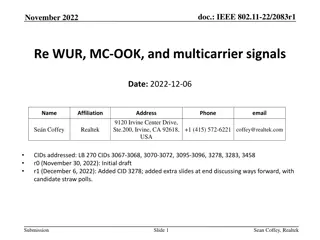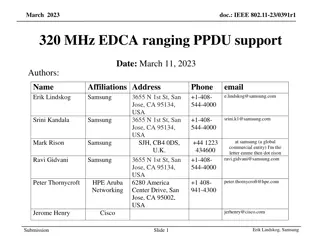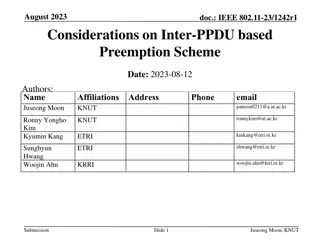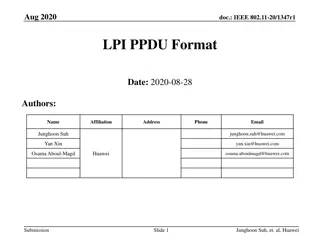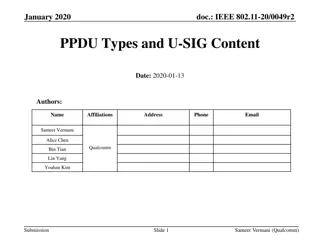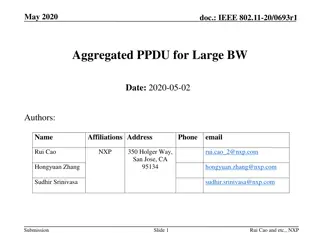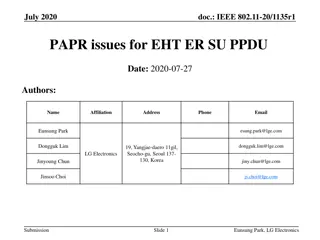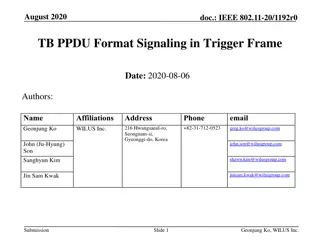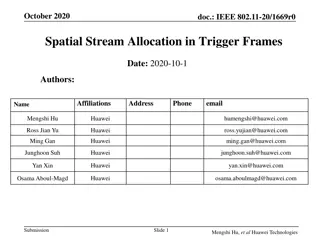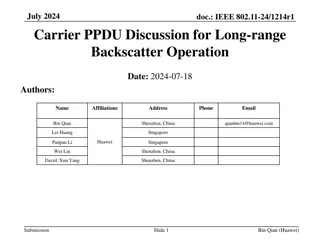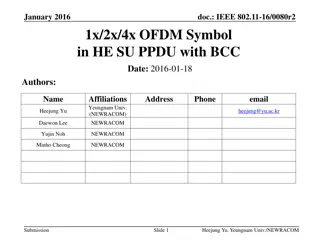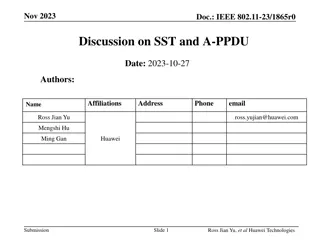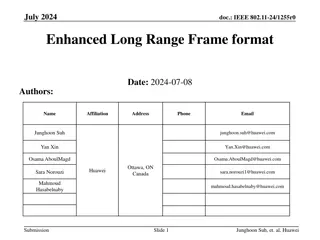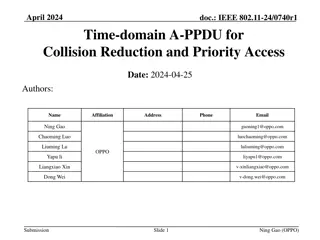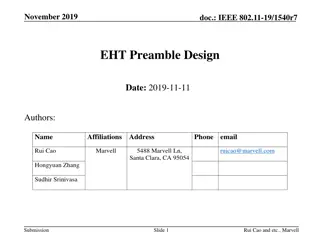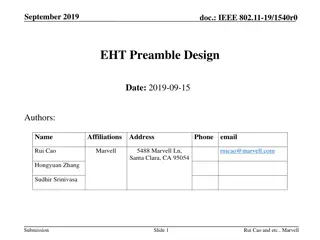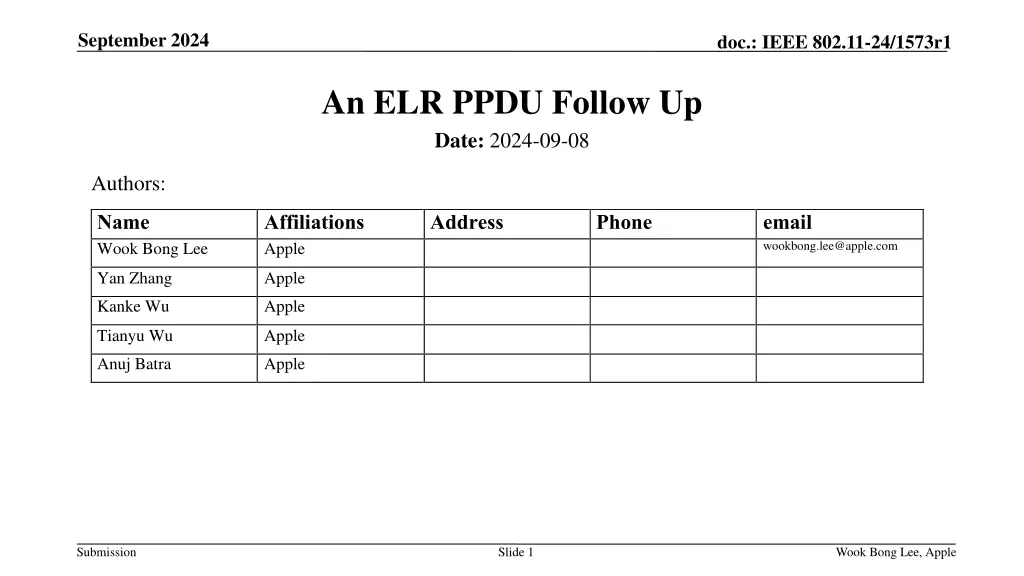
Improving Packet Detection Performance in IEEE 802.11-24/1573r1
In this document related to IEEE 802.11-24/1573r1, authors from Apple discuss enhancing packet detection performance to achieve a significant 6 dB link budget improvement over non-HT MCS0 or SU MCS0. The case study explores the impact of packet detection on different fields, focusing on schemes with ELR PPDU and packet detection at various points within a PPDU. Various transmission parameters and scenarios are analyzed to optimize packet detection efficiency and link budget.
Download Presentation

Please find below an Image/Link to download the presentation.
The content on the website is provided AS IS for your information and personal use only. It may not be sold, licensed, or shared on other websites without obtaining consent from the author. If you encounter any issues during the download, it is possible that the publisher has removed the file from their server.
You are allowed to download the files provided on this website for personal or commercial use, subject to the condition that they are used lawfully. All files are the property of their respective owners.
The content on the website is provided AS IS for your information and personal use only. It may not be sold, licensed, or shared on other websites without obtaining consent from the author.
E N D
Presentation Transcript
September 2024 doc.: IEEE 802.11-24/1573r1 An ELR PPDU Follow Up Date: 2024-09-08 Authors: Name Wook Bong Lee Affiliations Apple Address Phone email wookbong.lee@apple.com Yan Zhang Apple Kanke Wu Apple Tianyu Wu Apple Anuj Batra Apple Submission Slide 1 Wook Bong Lee, Apple
September 2024 doc.: IEEE 802.11-24/1573r1 Introduction In [1], [2] and [3], authors proposed to design a PPDU which improve 6 dB link budget over non-HT MCS0 or SU MCS0 In this contribution, how to improve packet detection performance to achieve this goal is discussed Submission Slide 2 Wook Bong Lee, Apple
September 2024 doc.: IEEE 802.11-24/1573r1 Packet Detection: Case Study (1/3) In [1], authors mentioned that it is desired to perform packet detection based on the first field, i.e. L-STF, in order not to disrupt CCA procedure To see the impact of packet detection on different field, a following case study was conducted Scheme 1: ELR PPDU w/ PD on the first field of a PPDU (e.g. L-STF) Scheme 2: ELR PPDU w/ PD on the UHR STF (e.g. end of UHR STF at 80 us after the PPDU starts) Measure time between the first packet (300 us PPDU length) generated by a DUT and received by an AP STA successfully Contention including collision + ELR RTS + CTS + ELR PPDU + ACK Maximum 8 retransmissions An AP STA and a non-AP STA use default EDCA parameters (Table 9-192 in REVme/D3.1) There are three non-AP STAs with downlink traffic and one or two non-AP STA(s) with uplink traffic (one of the non-AP STA is a DUT) Wook Bong Lee, Apple Submission Slide 3
September 2024 doc.: IEEE 802.11-24/1573r1 Packet Detection: Case Study (2/3) An AP STA Tx power: 30 dBm, a non-AP STA Tx power: 20 dBm Center frequency: 5 GHz, Channel B, 4dB Noise Figure BSS radios: 150 meter, a DUT is at 150 meter from an AP STA, other non-AP STAs (with downlink and uplink traffic) are randomly dropped within a BSS Packet detection threshold: -87dBm, Edge STA: uplink RSSI is less than packet detection threshold Traffic model is mix of VI, VO, BE for Downlink: Randomly selects traffic pattern from VI, VO and BE Uplink non-edge STA: Randomly selects traffic pattern from VI, VO and BE Uplink edge STA: Randomly selects traffic pattern from VI and VO Wook Bong Lee, Apple Submission Slide 4
September 2024 doc.: IEEE 802.11-24/1573r1 Packet Detection: Case Study (3/3) DL: three STAs, UL: one DUT + one other non-AP STA DL: three STAs, UL: one DUT 1 1 Scheme 1 Scheme 2 0.9 0.9 0.8 0.8 0.7 0.7 0.6 0.6 CDF CDF 0.5 0.5 0.4 0.4 0.3 0.3 0.2 0.2 0.1 0.1 Scheme 1 Scheme 2 0 0 0 1 2 3 4 5 6 7 8 9 10 0 1 2 3 4 5 6 7 8 9 10 Time [ms] Time [ms] Wook Bong Lee, Apple Submission Slide 5
September 2024 doc.: IEEE 802.11-24/1573r1 Discussion (1/3) As shown in slide 3-5, it is desired to perform packet detection based on the first field, i.e. L-STF, in order not to disrupt CCA procedure Typically, a WLAN receiver uses auto-correlation to estimate coarse CFO In a very low SNR region, auto-correlation has a limitation In order to improve PD, a receiver may use cross correlation To use cross correlation, the amount of phase difference should be small within the sequence for the correlation If a STA can correct CFO before transmission, then the receiver does not need to correct CFO before processing other fields (like TB PPDU transmission) At required SNR for downlink SU transmission with MCS0, we can achieve 10 kHz residual CFO at 1%-tile or 6 kHz error at 10%-tile (please refer slide 7) Smaller CFO will enable longer sequence to be used for cross correlation Submission Slide 6 Wook Bong Lee, Apple
September 2024 doc.: IEEE 802.11-24/1573r1 Discussion (2/3) The amount of value difference due to CFO in cross correlation is ?? ?????????? of samples in the sequence, c is the residual CFO value and t is time 15 kHz residual CFO 0.036 radian change for 2.4 us which is (0.9745 + 0.2243j)*signal For 15 kHz residual CFO case, the value difference is 0.07 dB Note that for 150 kHz residual CFO case, the value difference is 2 dB Thus, as long as the residual CFO value is not big, the packet detection threshold still works Residual CFO at 10% PER for RU242 MCS0 1 1x1 2x2 ??where N is the number 0.9 0.8 0.7 0.6 CDF 0.5 0.4 0.3 0.2 0.1 0 0 1 2 3 4 Residual CFO [kHz] 5 6 7 8 9 10 Submission Slide 7 Wook Bong Lee, Apple
September 2024 doc.: IEEE 802.11-24/1573r1 Discussion (3/3) 200B LDPC, Channel D 100 Packet detection algorithm assuming CFO pre-correction meets target performance requirement with 3 dB L-STF and L-LTF boosting 1x1 2x2 2x4 10-1 PER Link Budget Improvement 8.81 dB 7.56 dB 6.34 dB Note that for downlink, non-AP STA can use improved packet detection algorithm (e.g. CFO precorrection at receiver side) which has more than 3 dB margin over MCS0 sensitivity level 10-2 1x1, ELR MCS0 2x2, ELR MCS0 2x4, ELR MCS0 11 10 9 8 7 6 5 4 Link Budget Improvement [dB] Submission Slide 8 Wook Bong Lee, Apple
September 2024 doc.: IEEE 802.11-24/1573r1 Conclusion In this contribution, Proposed to perform packet detection based on the first field, i.e. L-STF Proposed a preprocessing mechanism for L-STF and L-LTF in ELR PPDU Showed that 3 dB boosting with CFO precorrection can achieve 6 dB link budget improvement Submission Slide 9 Wook Bong Lee, Apple
September 2024 doc.: IEEE 802.11-24/1573r1 SP #1 Do you agree to add following text to the TGbn SFD? Define an enhanced long range (ELR) PPDU in IEEE 802.11bn with the following targets Downlink and Uplink in 2.4 GHz (within BSS range with 11b beacon) Uplink only in 5 GHz and 6 GHz bands Minimum data rate is greater than or equal to 1.5 Mbps Submission Slide 10 Wook Bong Lee, Apple
September 2024 doc.: IEEE 802.11-24/1573r1 SP #2 Do you agree to add the following text to the TGbn SFD? In ELR PPDU, STA boosts L-STF and L-LTF by 3 dB For UL, non-AP STA corrects CFO before transmission Note: Non-AP STA pre-correction CFO requirement for residual CFO is TBD Submission Slide 11 Wook Bong Lee, Apple
September 2024 doc.: IEEE 802.11-24/1573r1 References [1] 11-24/921r0, An Enhanced Long Range PPDU [2] 11-24/873r0, Design Targets and Considerations for Enhanced Long Range [3] 11-24/875r1, UHR Enhanced Long Range Support [4] OFDM Wireless LANs: A Theoretical and Practical Guide 1st Edition by Juha Heiskala (Author), John Terry Ph.D. ISBN-13:978-0672321573 [5] OFDM Baseband Receiver Design for Wireless Communications by Tzi- Dar Chiueh, Pei-Yun Tsai. ISBN: 978-0-470-82234-0 Submission Slide 12 Wook Bong Lee, Apple
June 2024 doc.: IEEE 802.11-24/1573r1 Appendix: Impact of Larger Residual CFO 200B LDPC, Channel D, Non Ideal PD, BD, CFO, CHE 100 10-1 PER 1x1 RU52 FD 15kHz 2x2 RU52 FD 15kHz 2x4 RU52 FD 15kHz 1x1 RU52 FD 30kHz 2x2 RU52 FD 30kHz 2x4 RU52 FD 30kHz 1x1 RU52 FD 40kHz 2x2 RU52 FD 40kHz 2x4 RU52 FD 40kHz 10-2 11 10 9 8 7 6 5 4 3 Link Budget Improvement [dB] Submission Slide 13 Wook Bong Lee, Apple



